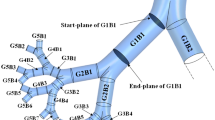Abstract
It is shown in this paper that the nearly constant length-to-diameter ratio observed with conducting airways of human bronchial tree can be explained based on the fluid dynamic optimality principle. In any branched tube there are two pressure loss mechanisms, one for wall friction in the tube section and the other for flow division in the branching section, and there exists an optimal length-to-diameter ratio which minimizes the total pressure loss for a branched tube in laminar flow condition. The optimal length-to-diameter ratio predicted by the pressure loss minimization shows an excellent agreement with the length-to-diameter ratios found in the human conducting airways.




Similar content being viewed by others
Abbreviations
- A :
-
cross sectional area
- a :
-
constant
- d :
-
tube diameter
- F :
-
proportional constant between pressure loss coefficient and Reynolds number
- K :
-
pressure loss coefficient
- l :
-
tube length
- n :
-
generation number
- P :
-
pressure
- ΔP :
-
pressure drop or loss
- ΔP b :
-
pressure drop due to branching or flow division
- ΔP s :
-
pressure drop due to wall friction
- Q :
-
volumetric flow rate
- Re :
-
Reynolds number, Vd/ν
- V :
-
flow velocity
- μ:
-
dynamic viscosity
- ν:
-
kinematic viscosity
- ρ:
-
density
- Θ:
-
branching angle
- 0:
-
mother branch
- 1:
-
major daughter branch
- 2:
-
minor daughter branch
References
Dankelman J, Cornelissen AJ, Large J, VanBavel E, Spaan JA (2007) Relation between branching patterns and perfusion in stochastic generated coronary arterial trees. Med Biol Eng Comput 45:25–34
Flaaris JJ, Volden M, Haase J, Ostergaard LR (2004) Method for modeling cerebral blood vessels and their bifurcations using circular, homogeneous, generalized cylinders. Med Biol Eng Comput 42:171–177
Horsfield K, Cumming G (1967) Angles of branching and diameters of branches in the human bronchial tree. Bull Math Biophys 29:245–259
Horsfield K, Cumming G (1968) Morphology of the bronchial tree in man. J Appl Physiol 24(3):373–383
Isaby D, Chang HK (1981) Steady and unsteady pressure flow relationships in central airways. J Appl Physiol 51:1338–1348
Ito H, Imai K (1973) Energy losses at 90 degree pipe junctions. Proc ASCE J Hydraulics Div 99:1353–1368
Jamison DK, Villemonte JR (1971) Junction losses in laminar and transitional flows. Proc ASCE J Hydraulics Div 97(HY7):1045–1063
Liu Y, So RMC, Zhang CH (2002) Modeling the bifurcating flow in a human lung airway. J Biomech 35:465–473
Miller DS (1971) Internal flow. A guide to losses in pipe and duct systems. British Hydromechanics Research Association, Cranfield
Phalen RF, Yeh HC, Schum GM, Raabe OG (1978) Application of an idealized model to morphometry of the mammalian tracheobronchial tree. Anat Rec 190:167–176
Phillips CG, Kaye SR, Schroter RC (1994) A diameter-based reconstruction of the branching pattern of the human bronchial tree. Respir Physiol 98:193–217
Phillips CG, Kaye SR (1995) Diameter-based analysis of the branching geometry of four mammalian bronchial trees. Respir Physiol 102:303–316
Rashevsky N (1960) Mathematical biophysics, vol 2, chapter XXVII. Dover Publications Inc., New York, pp 292–305
Ward-Smith AJ (1980) Internal fluid flow the fluid dynamics of flow in pipes and ducts, Chapter J. Oxford University Press, New York
Weibel ER (1963) Morphometry of the human lung. Academic, New York
Zamir M (1976) Optimality principles in arterial branching. J Theor Biol 62:227–251
Acknowledgment
This work was supported by MOST(KOSEF) through Systems Bio-Dynamics Research Center.
Author information
Authors and Affiliations
Corresponding author
Rights and permissions
About this article
Cite this article
Lee, J.W., Kang, M.Y., Yang, H.J. et al. Fluid-dynamic optimality in the generation-averaged length-to-diameter ratio of the human bronchial tree. Med Bio Eng Comput 45, 1071–1078 (2007). https://doi.org/10.1007/s11517-007-0232-8
Received:
Accepted:
Published:
Issue Date:
DOI: https://doi.org/10.1007/s11517-007-0232-8




